The beautiful marriage of hops and craft beer
Posted by Andre on 2nd Dec 2015
Beer is loved the world over for a good reason. It’s been part of the culture of countries in all four corners of the Earth for the better part of 10,000 years. Lately, we’ve seen an explosion of beer styles and flavours burst onto the market, produced using techniques ranging from modern scientific processes, to alternative ingredients that were used by our ancestors before law or governments even existed!
To fully appreciate the skill and patience required to brew the perfect beer, it’s important to have some understanding of the journey beer has gone through. Beer brewing is a constantly evolving beast, with the porridge-like beer of our forefathers nothing like the refreshing bottles of liquid we drink today.
What was used before hops to flavour beer?
Right around the world, civilisations have been brewing their own beer versions using the staple ingredients of water, grains and in very recent times, yeast. Yet the first record of hops being used in beer was around 400BC, while widespread use has only really taken place during the last 600 years.
So what did beer makers use before hops?
The answer to that question is as wide and varied as the Earth we live on. Each civilisation used the ingredients they found in their local area to flavour their beer. As such the varieties of beers produced through the ages are literally incalculable. For example:
- A beer discovered in China contained sake rice, wildflower honey, Muscat grapes, hawthorn fruit and chrysanthemum.
- A particular Turkish beer discovered in the tomb of King Midas contained honey, Muscat grapes and saffron.
- An ancient drink discovered in Honduras contained cocoa powder, cocoa nibs, honey, chillies and annatto - possibly the world’s first alcoholic chocolate milkshake!
However, large quantities of incredibly sweet liquids are impossible to consume. As such the earliest brewers began using ingredients to give beers their distinctive bitter taste, so people could enjoy more of their product in one sitting. The best way to do this was to add herbs and plants, with some of the most common including:
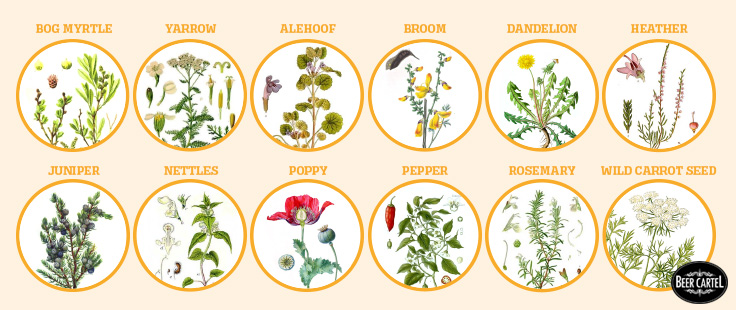
The style of using a mixture of herbs to flavour beer is called gruit. This technique was widespread for thousands of years until hops started to be used extensively throughout Europe, first by the Romans in the east from the 11 th century, until they reached Britain around 500 years later.
When were hops first used in beer?
When hops first made their grand entrance into the art of beer making is a hotly debated topic. While historical records show that the first mention of hops possibly being used in the beer brewing process were by captive Jews in Babylon several hundred years BC, it wasn’t until 736 AD that humans actually began to cultivate hops for specific use. Before that they just grew wild and people had to forage for them.
There are contradictory reports about when hops were definitely first used for brewing beer. One report suggests a Benedictine Abbot in France documented in a series of statutes used to run the monastery that hops were to be gathered to produce beer. However, the vast majority of historical evidence suggests the abbot only mentioned using hops for salads, a cure for insomnia, in shampoo and as a hide tanning preservative.
The more accepted date that most historians use to signal the introduction of hops into the beer brewing process is 1079 AD when Hildegarbe, a Benedictine nun in Germany, wrote a book about health and healing. She also noted their preservative qualities, suggesting they should be added to drinks, including beer, because they help them last much longer.
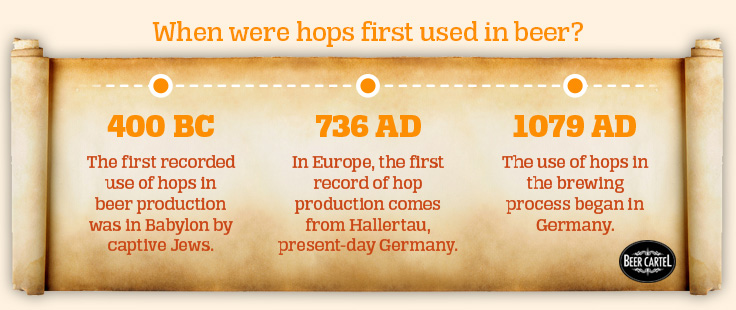
The Germans quickly began exporting hops to Flanders and Holland, before their use spread right across Europe over the next 400 years. It wasn’t until 1629 that hops began to be cultivated in the United States by English and Dutch farmers.
In Australia, the first evidence of beer brewing was by a convict named James Squire in around 1793. Squire claimed in 1820 that he’d been brewing beer for 30 years using hops sourced from the HMS Daedalus. However it wasn’t until 1806, after three years of trying, that Squire began cultivating his own hops. He presented them to Governor King, a firm supporter of beer brewing to combat the scourge of rum trafficking by the British Army, who was so impressed he “directed a cow to be given to Mr Squire from the Government herd” (Sydney Gazette, 16 March 1806).
James Squire died in 1822, and after his son and several relatives ran Squire’s brewery, ill-health and deaths resulted in its demise in 1834. In 1999, brewing giant Lion Nathan released a line of James Squire beers in honour of Australia’s first hop grower and commercial brewer.
Who are the world’s top hop producers?
Hops are generally grown in moist temperate climates, enjoying the same soil composition as potatoes. Optimal growing spots around the world tend to be between the 35 th and 55th lines of latitude in both the northern and southern hemispheres. This includes the Pacific Northwest of the USA; European countries such as England, Belgium and Germany; and the growing Southeast Australian and New Zealand markets. Here hop plants enjoy long, hot summer days and cold winters. This cold period is important for hop growing, as the plant goes dormant and energy is concentrated into the roots.
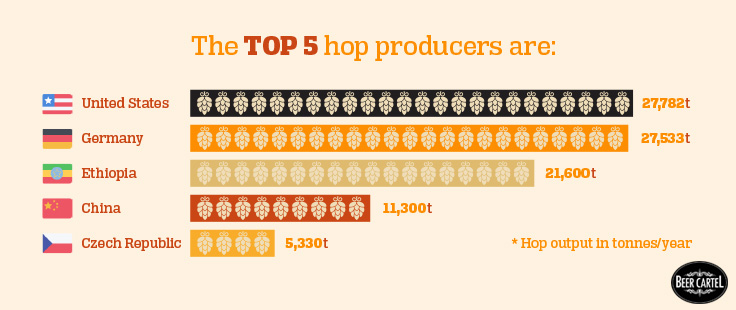
The Australian hop industry is growing fast, particularly with the recent explosion of craft beers on the market. Hops are grown predominantly in North Eastern Victoria, and Tasmania’s Derwent Valley, with exports at record levels thanks to demand from local and Asian brewers, particularly China and India.
The rise of craft beers and hop varieties
There has been a quiet beer revolution going on in Australia and around the world over the recent years, which is now impossible to ignore. Small breweries have been clawing away at the mass beer market by creating a refreshing new variety of beers to choose from, and the big boys have been taking notice.
While the days of mass-produced beer isn’t going anywhere soon, the quantity of traditional beer being consumed is decreasing, while the opposite is true for craft beers. Beer drinkers are now far more sophisticated and educated than ever before, preferring quality over quantity, and are willing to pay a premium for it.
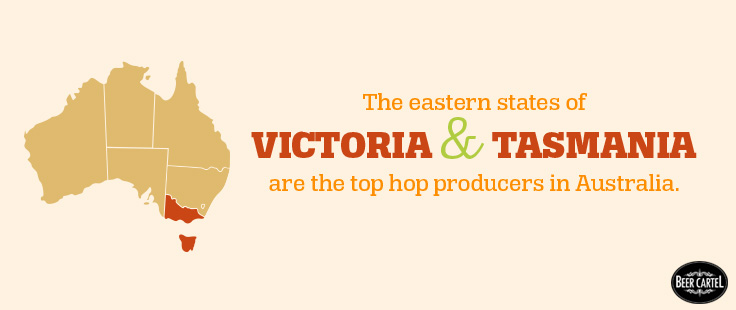
There are now approximately 150 microbreweries in Australia, cumulatively producing a $160 million craft beer industry. They’re independent and traditional, and the industry is expected to grow by another 10% over the next five years. As such, the amount of hops being produced in Australia and around the world has also dramatically increased. The explosion of beer flavours and styles being produced by microbreweries has resulted in a proliferation of hops being grown.
The first breeding of different hop varieties took place in 1919 by E. S. Salmon at Wye College in Kent, England. Globally there are now around 80 varieties in commercial use, with a lot more in the developmental stage.
Here are the 10 popular hops currently being produced in Australia:
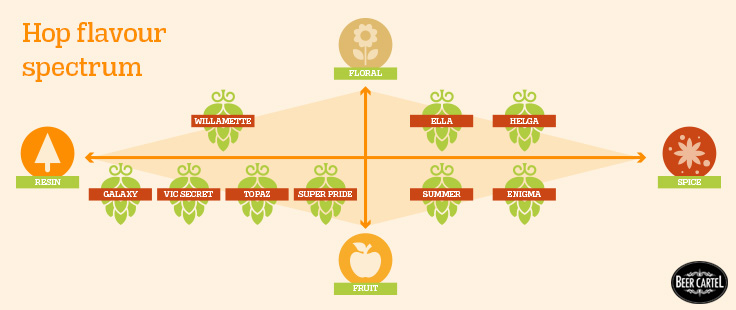
- Ella – Generally displays floral and spice notes, best used in lagers and pilsners.
- Helga – A delicate floral and subtle herbal aroma, best used in stronger malt driven ales and lagers.
- Williamette – Known for its mild, pleasant floral, resinous and spicy characteristics.
- Super Pride – Its combination of resin and fruit influences the beer’s aroma.
- Summer – Used in a range of beer styles, it adds subtle, light apricot and melon flavours.
- Topaz – A very adaptable hop, depending on how it’s used. Dry hopping provides resinous, grassy flavours; while pleasant, light tropical flavours become more pronounced in higher gravity brews.
- Cascade – Found in many of Australia’s best craft beers, it has a medium strength aroma with fruity characteristics.
- Vic Secret – Displays clean fruit and pine characteristics.
- Enigma – A newcomer to the hop family, it’s been described as ‘raspberries’, ‘red currant’, rock melon, and ‘tropical fruit’.
- Galaxy – The most internationally recognised hop in Australia, it’s defined by its passionfruit, peach and clean citrus aromas.
What is a hop and what does it do?
Hops are part of the same plant family as marijuana, called Cannabaceae. It’s one of the four key ingredients in beer, along with water, yeast and grain. A hop plant is known as a bine (not to be confused with a vine which uses tendrils or suckers to climb), a climbing plant that holds itself in place by using thick, downward facing hairs around some sort of support (e.g. wooden pole).
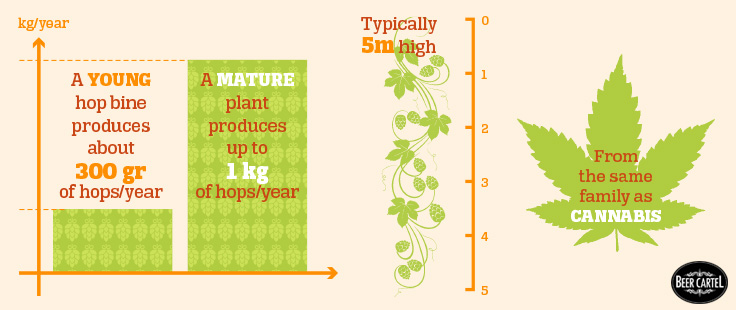
- It’s the flower of the hop that is used in the beer brewing process.
- At the start of spring the hop will start to bloom.
- During its peak growing period, bines can grow from 2-7 centimetres per day.
- By the time the colder winter months arrive, the bine will lose all of its sprouts, the growing process will cease, and all energy will be diverted into its root system.
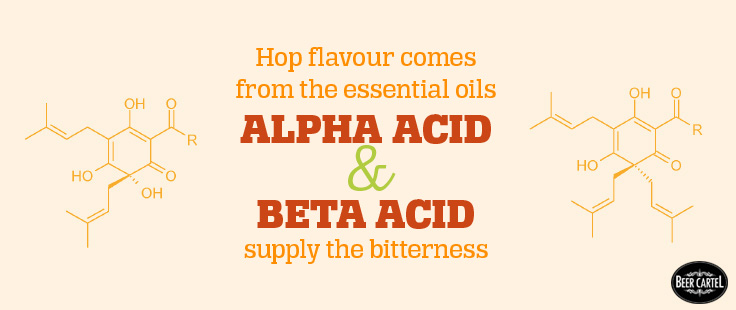
Within the hop flower are alpha and beta acids, as well as essential oils, which combine to create the distinct bitter taste found in beer. This is used to counter the sweet malt flavour produced by the other ingredients, and also acts as a preservative so the beer lasts longer.
The art of beer making is all about experimenting with the ratio between sweet maltiness and bitterness, by using a range of hops with varying flavours and aromas. The way hops influence a beer’s flavour and aroma depends on the kind of hops used, and when they are added to the beer brewing process.
- Hops added at the start of the boiling process will give the beer a high degree of bitterness.
- Adding hops towards the end of the boil (for example 10-15 minutes), will result in less bitterness and more flavour.
- If the hops are added right at the end (for example, the final two minutes), you’ll get less flavour and a hoppier aroma.
- Dry hopping, the process of placing hops into the beer after fermentation and usually before packaging for a period of 1 or 2 weeks, will add lots of aroma but very little bitterness.
Danger to pets, particularly cats and dogs
With the increasing popularity of home brewing around the world, including here in Australia, more people are storing hops in their home. Hops are a danger to cats and dogs, so it’s vital you keep them stored safely and securely if your pets and hops are near each other.
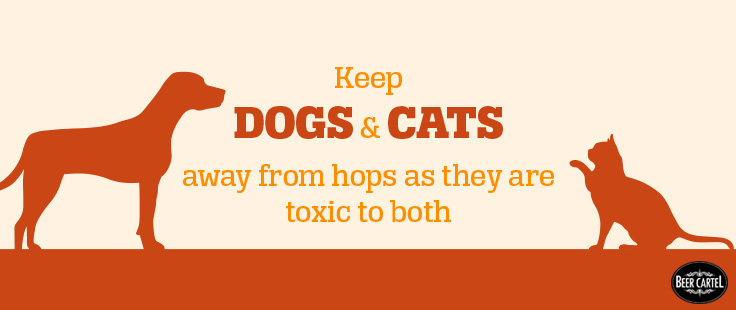
The reaction your cat or dog can expect after eating hops will depend on the amount consumed, and can range from mild to severe. Common symptoms of hop ingestion include:
- Increase in body temperature (above 40.6°)
- Faster breathing
- Elevated heart rate
- Anxiety
- Vomiting
- Seizures
- Abnormal clotting
Dogs are far more likely to eat hops than cats, and in the most severe cases, they can die within six hours of ingestion. Any breed of dog can be affected, but it’s those who are prone to dramatic increases in body temperature that are most in danger. These include:
- Greyhounds
- Labradors
- St. Bernards
- Pointers
- Dobermans
- Border Collies
- English Springer Spaniels
To ensure your dog or cat doesn’t ingest any of your hops, don’t:
- Leave hops lying around unattended
- Empty hop sediment into the yard where dogs and cats have access
- Have hop plants in the yard where hop cones can fall to the ground
If your cat or dog has ingested hops, take them to the nearest pet hospital for immediate treatment.
What's next for beer?
The beer journey truly has gone full circle, from local brewers using ingredients close at hand to make beers unique to their surroundings, through to the age of mass produced beer from global conglomerates, and now slowly back to smaller microbreweries using time honoured traditions, processes and ingredients once again.
It’s been a fascinating journey through the centuries, and it makes you wonder what the future holds for the beer brewing industry as a whole. With the advent of the Internet and the power to access information whenever we need it, one thing is for certain. Beer consumers will no longer blindly drink what has been put in front of them. The majority will now expect to know who has produced the beer, where the ingredients have come from, and what possible flavours and aromas they can expect before opening it.
The trend so far is a sharp rise in craft beer production, and steady decline in mass-produced products. The forecast for the short to medium term is a continuation of this trend, which will likely see an increase in the number of microbreweries and craft beers on the market for the foreseeable future.

 Loading... Please wait...
Loading... Please wait...

